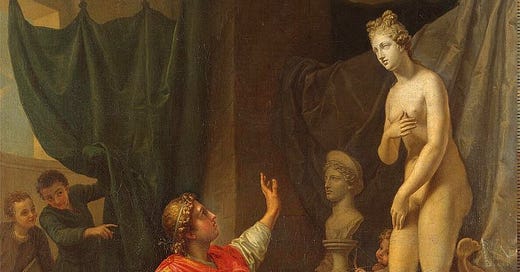Henry Higgin's Twisted Vision
On George Bernard Shaw's inversion of the myth of Pygmalion and Galatea
It needs to be acknowledged up front that I am emphatically not a man. In fact, I tend to be what folks call a girly girl. I wear make up every day, I adore British period dramas, and I am bored senseless by sports cars and March Madness and online poker and the economy. However, I am very interested in human nature, which includes, of course, men. Perhaps because for better or worse I fit into a stereotypically feminine paradigm, I find the masculine soul a fascinating and delightful mystery. Since out of decorum I cannot wander about interviewing all the men in my life about their core masculine identities (sigh), I must make do with observations, conversations, and books, which have at times bewildered, instructed and captivated me. In a cultural climate that seems to have misplaced a proper understanding of healthy masculinity, I enjoy learning from thinkers who portray and interpret manhood. George Bernard Shaw undertakes this subject in his brilliant satirical comedy, Pygmalion.
The manifestations of masculine desire in Pygmalion particularly interests this girly girl who happens to be writing a book on duty and desire in literature and life. At the center of the play is the dynamic between brash phonetician Henry Higgins and his strong-willed protege, Eliza Doolittle. Higgins sets out to win a bet with a colleague to prove he is capable of transforming the graceless Cockney Eliza into a poised, eloquent woman. Eliza proves an able pupil, but Higgins sees only his own accomplishment. When she dazzles guests at an ambassador’s garden party six months later, Higgins handily wins the bet. Satisfied with himself and bored by the endeavor, he considers the project ended. But Eliza refuses to be treated as a finished product, demanding that Higgins acknowledge her as a human being with whom he has forged a meaningful relationship. Conflict ensues, and Act V ends not romantically but ambiguously.
The play is based on an ancient myth about a sculptor named Pygmalion who carves his ideal woman out of marble so skillfully that he falls in love with his own creation. The goddess Venus, intrigued by this unusual love story, transforms the statue into a living woman, enabling Pygmalion and his enfleshed ideal, Galatea, to live happily ever after. The myth raises questions about art, love, and identity. Shaw embeds the same questions into his adaptation of the myth, but complicates them with an ambivalent relationship between the central couple. Unlike Pygmalion and Galatea, Higgins and Eliza do not marry, but they do form a bond. If it is not romantic, what is the nature of that bond?
Keep reading with a 7-day free trial
Subscribe to Close Reads Podcast HQ to keep reading this post and get 7 days of free access to the full post archives.






